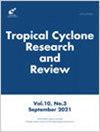Application research of wind profile radar in short-term heavy rainfall forecast of typhoon in Fujian Province
IF 4.1
4区 地球科学
Q3 METEOROLOGY & ATMOSPHERIC SCIENCES
引用次数: 0
Abstract
Based on wind profile radar data, this paper aims at different typhoon processes landed and affected Fujian from 2011 to 2019, according to the nature of typhoon rainstorm, it can be classified into outer precipitation before typhoon landed, main body precipitation and precipitation at the rear of typhoon, the change of the characteristic quantities in approaching time of the occurrence of short-term heavy rainfall was analyzed, and the typhoon case in 2020 was back calculated. The results show that, the characteristics of low-level jet streams (maximum wind speed at low altitude, minimum height of jet streams, and low-level jet stream index), as well as the magnitude of vertical wind shear below 700 hPa, have important indicative significance for the occurrence of short-term heavy rainfall. (1) More than 80 % of short-term heavy rainfall occurred 3 h before the low-level jet stream already existed. The maximum wind speed below 2 km was basically close to a normal distribution, and the occurrence of heavy precipitation showed a bimodal pattern. The percentage of wind speed between 8 and 32 m/s was the highest, exceeding 85 %. The wind direction of the strong wind is mainly NE, SE, and SW. Classification analysis showed that the distribution characteristics of wind speed of the main precipitation were the same as before, but the wind direction SE was higher than NE. The wind speed of pre-landfall precipitation was basically skewed, and the occurrence time of heavy precipitation followed a normal distribution. The percentage of wind speed between 16 and 32 m/s was the highest, and the wind direction was the same as before classification. The maximum wind speed of precipitation in the rear was basically bimodal distribution, with a relatively even distribution, and the wind direction was mainly SE and SW. (2) In the 3 h before the occurrence of short-term heavy precipitation, there was an increase in the maximum wind speed value, a decrease in the minimum extension height, and an increase in the low-level jet stream index I. As short-term heavy rainfall approached, the intensity of the low-level jet stream remained high and its proportion increased. The minimum achievable extension height gradually decreased and remained stable at a low value. In the first 2 h of heavy rainfall, the wind speed reached its maximum, the extension height was the lowest, and the low-level jet stream index I was the highest. Classifying and discussing it, the precipitation in the rear was different, and the lowest height decreased to the lowest at the time of occurrence, at which point the I value reached its maximum. The characteristics of the other two categories were the same as before the classification. (3) The vertical wind shear from the ground to different isobaric surfaces gradually decreased with the increase of height. With the approach of short-term heavy rainfall, the vertical wind shear of each layer basically decreased gradually, after the beginning of heavy rainfall, which decreased to the minimum. The characteristics of main body precipitation were the same as before the classification. Pre-landfall precipitation, in addition to the gradual decrease of vertical wind shear from the ground to 925 hPa, both 850 hPa and 700 hPa increased first and then decreased, vertical wind shear decreased to the minimum after the beginning of heavy rainfall. Precipitation at rear of typhoon, vertical wind shear from ground to 700 hPa increased compared with that before the occurrence of heavy rainfall, while wind shear from ground to 925 hPa and 850 hPa showed the characteristics of decreasing when heavy rainfall occurred. (4)The median values of various physical quantities before the occurrence of typhoon short-term heavy rainfall were selected as the thresholds of short-term heavy rainfall will occur. The intensity of LLJ is about 21 m/s, the lowest height is about 0.65 km, the LLJ index I is about 36 × 10−3s−1. Vertical wind shear from the ground to 925 hPa, 850 hPa and 700 hPa are respectively about 15.9 × 10−3s−1, 11.2 × 10−3s−1 and 5.1 × 10−3s−1.
风廓线雷达在福建省台风短时强降水预报中的应用研究
本文基于风廓线雷达资料,针对2011 - 2019年登陆并影响福建的不同台风过程,根据台风暴雨的性质,将其分为台风登陆前外围降水、台风主体降水和台风后方降水,分析了短期强降雨发生接近时间特征量的变化,并反演了2020年的台风场次。结果表明,低空急流特征(低空最大风速、低空急流最小高度、低空急流指数)以及700 hPa以下垂直风切变强度对短时强降水的发生具有重要指示意义。(1) 80%以上的短期强降水发生在低空急流存在前3 h。2 km以下最大风速基本接近正态分布,强降水的发生呈双峰型。风速在8 ~ 32 m/s之间的比例最高,超过85%。强风风向以东北、东南、西南为主。分类分析表明,主降水的风速分布特征与前一次相同,但风向偏东南大于偏东北。登陆前降水风速基本偏斜,强降水发生时间服从正态分布。风速在16 ~ 32 m/s之间的比例最高,风向与分级前相同。后方降水最大风速基本为双峰分布,分布相对均匀,风向以东南和西南为主。(2)在短时强降水发生前3 h,最大风速值增大,最小延伸高度减小,低空急流指数1增大,随着短时强降水的临近,低空急流强度保持高位,所占比例增大。最小可达延伸高度逐渐减小并稳定在低值。强降水前2 h风速最大,延伸高度最低,低空急流指数I最高。对其进行分类讨论,后方降水不同,最低高度在发生时降至最低,此时I值达到最大值。另外两类的特征与分类前相同。(3)从地面到不同等压面的垂直风切变随高度的增加逐渐减小。随着短时强降水的临近,各层垂直风切变基本逐渐减小,在强降水开始后减小到最小值。主体降水特征与分级前基本一致。登陆前降水,从地面到925 hPa垂直风切变逐渐减小,850 hPa和700 hPa均先增大后减小,在强降水开始后垂直风切变减小至最小。台风后方降水、地面至700 hPa垂直风切变较强降水发生前增加,而地面至925 hPa和850 hPa垂直风切变在强降水发生时呈减少特征。(4)选取台风短时强降雨发生前各物理量的中位数作为短时强降雨发生的阈值。LLJ强度约为21 m/s,最低高度约为0.65 km, LLJ指数I约为36 × 10−3s−1。从地面到925 hPa、850 hPa和700 hPa的垂直风切变分别约为15.9 × 10−3s−1、11.2 × 10−3s−1和5.1 × 10−3s−1。
本文章由计算机程序翻译,如有差异,请以英文原文为准。
求助全文
约1分钟内获得全文
求助全文
来源期刊

Tropical Cyclone Research and Review
METEOROLOGY & ATMOSPHERIC SCIENCES-
CiteScore
4.60
自引率
3.40%
发文量
184
审稿时长
30 weeks
期刊介绍:
Tropical Cyclone Research and Review is an international journal focusing on tropical cyclone monitoring, forecasting, and research as well as associated hydrological effects and disaster risk reduction. This journal is edited and published by the ESCAP/WMO Typhoon Committee (TC) and the Shanghai Typhoon Institute of the China Meteorology Administration (STI/CMA). Contributions from all tropical cyclone basins are welcome.
Scope of the journal includes:
• Reviews of tropical cyclones exhibiting unusual characteristics or behavior or resulting in disastrous impacts on Typhoon Committee Members and other regional WMO bodies
• Advances in applied and basic tropical cyclone research or technology to improve tropical cyclone forecasts and warnings
• Basic theoretical studies of tropical cyclones
• Event reports, compelling images, and topic review reports of tropical cyclones
• Impacts, risk assessments, and risk management techniques related to tropical cyclones
 求助内容:
求助内容: 应助结果提醒方式:
应助结果提醒方式:


